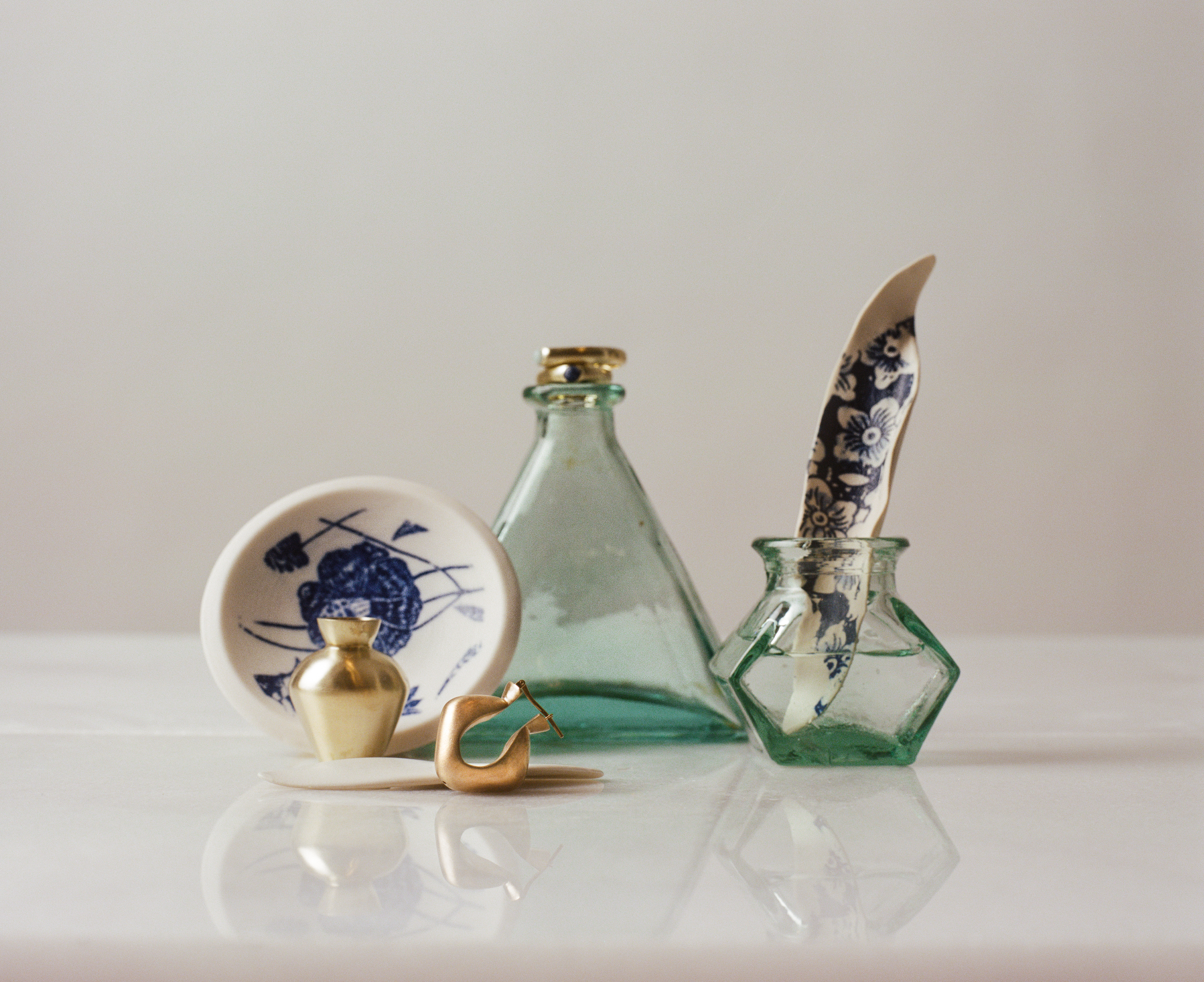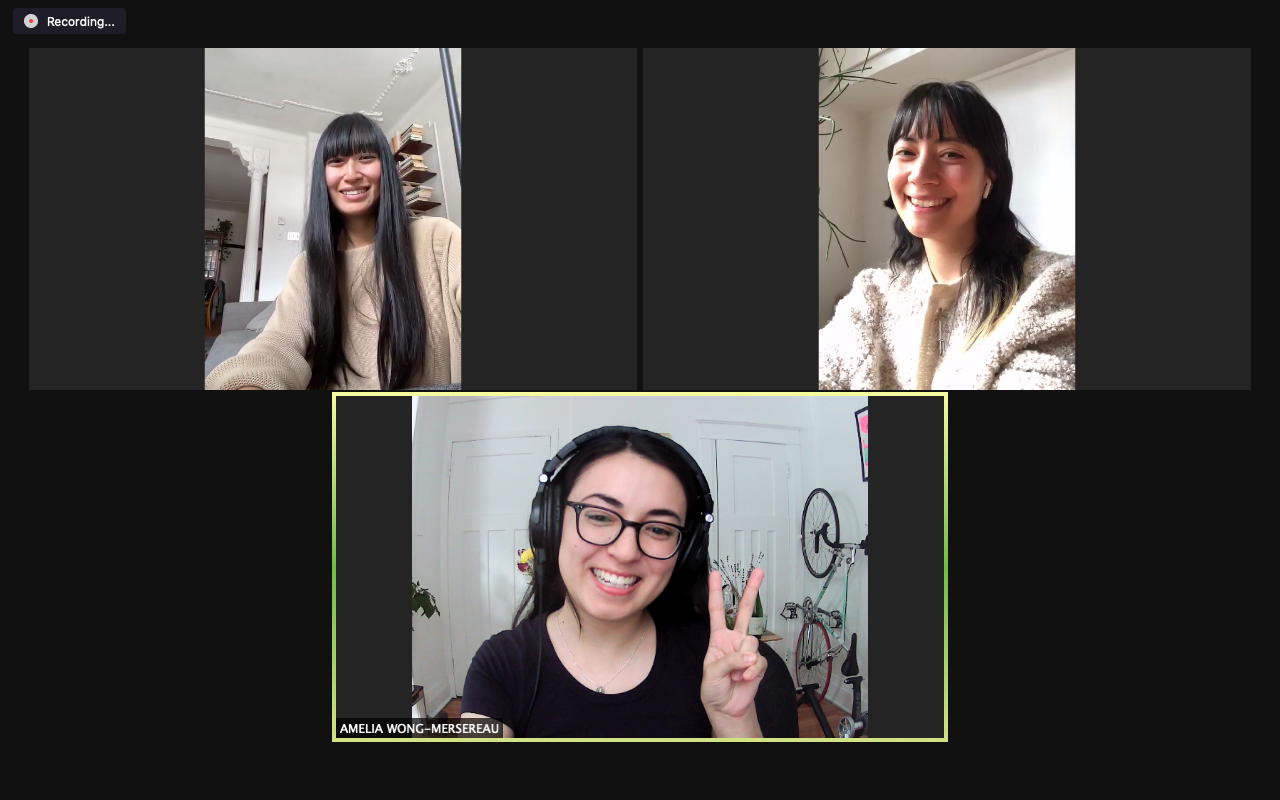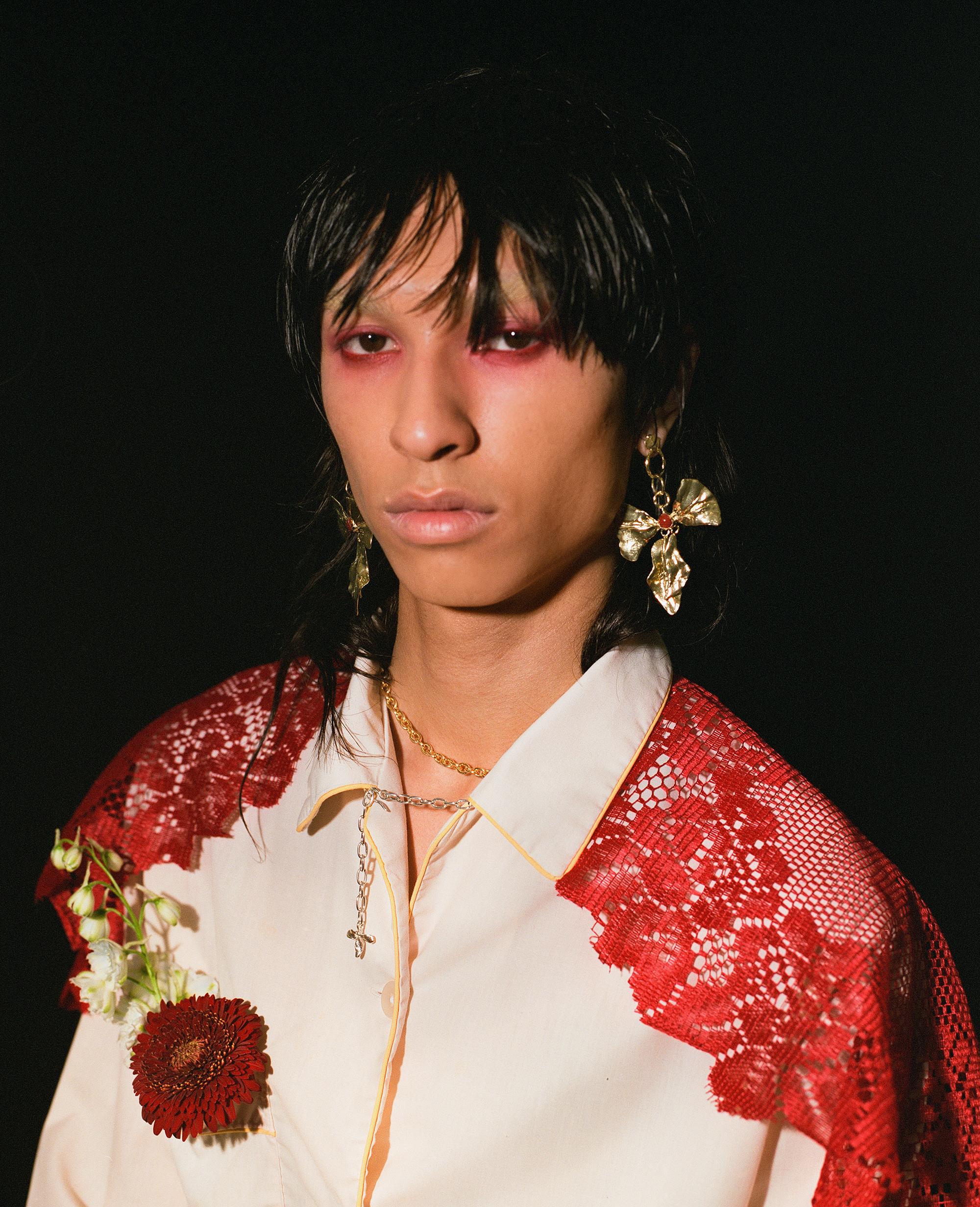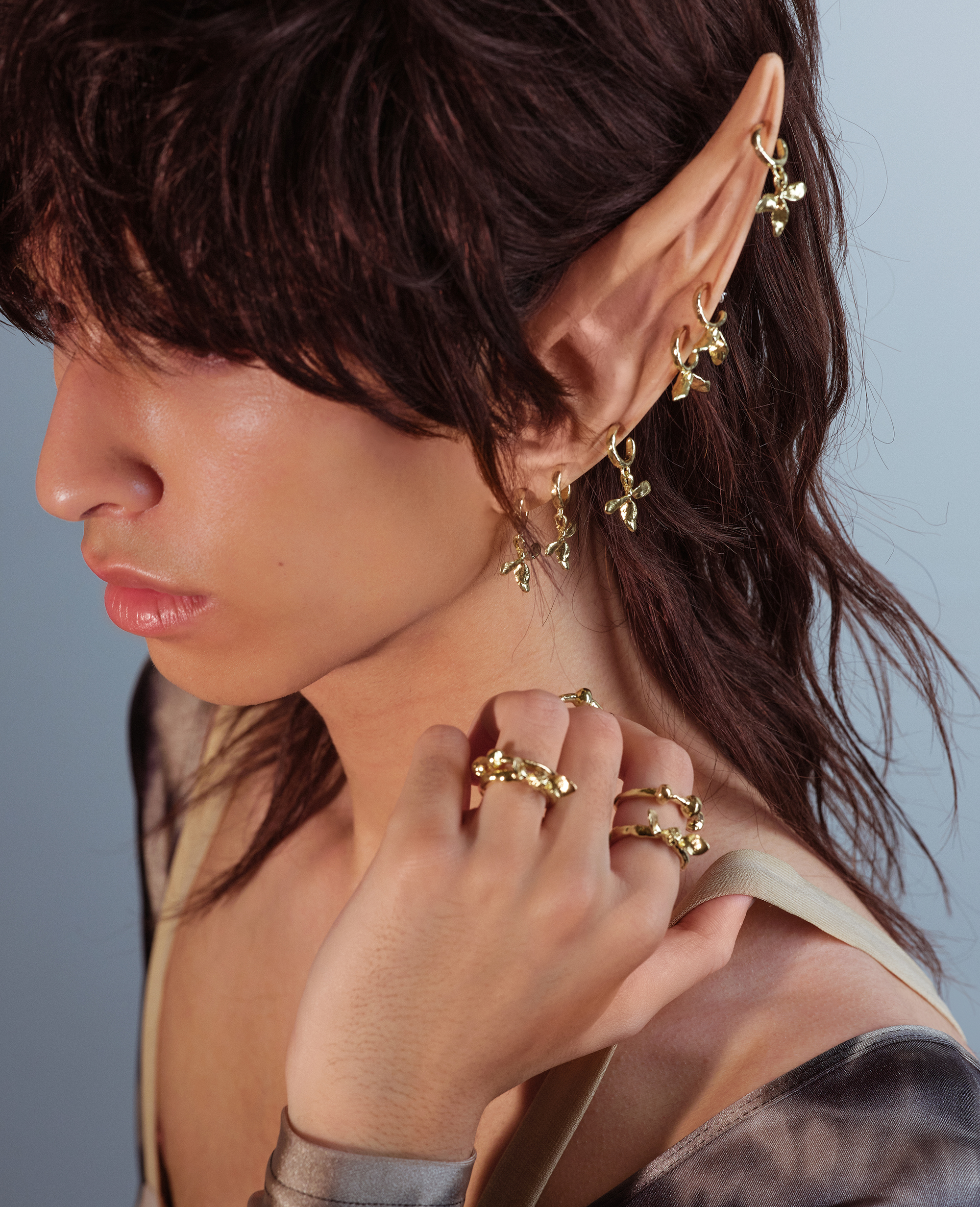
YUUN, "Vessels" (2020). Photo credit: JG+SHI (@jgandshi)
Carving the Self Out of Metal and Stone
An interview with Caroline Pham (ORA-C) and Lina Hu (YUUN)
Words by Amelia Wong-Mersereau
Photos courtesy of ORA-C and YUUN
June 17, 2021
Photos courtesy of ORA-C and YUUN
June 17, 2021
The COVID-19 pandemic has made it a difficult time for artists to stay connected with each other, let alone earn a living. In the Montreal arts community, many creatives find inspiration through gatherings, studio visits, exhibitions, and events. ORA-C and YUUN are two Montreal-based jewelry brands respectively run by Caroline Pham and Lina Hu, who I found out were already friends. They were more than willing to invite me into their world and to connect through a conversation about their creative practices and artistic vision.
Since all of us happen to be Canadian-born with connections to China, we found many commonalities and became quickly familiar. Like me, Pham was born and raised in Montreal and is of mixed ethnic background with a Vietnamese father and a French Canadian mother. At 14, her family moved to Hong Kong where she attended a French international school. She eventually found her way back to North America, attending college in New York City and then moving back to Montreal.
On the other side of the country, Hu was born and raised the daughter of Chinese immigrants in Vancouver. She moved to Montreal in 2011 where she discovered, as many young creatives do, a welcoming arts community. Pham’s return to Montreal was a similar experience to Hu’s, and the two point to Souk, the annual showcase supporting local designers and artists, as an important event that helped crystallize their friendship and allowed them to meet other creatives. Our conversation ended up delving deeper than I expected into questions of identity, upbringing, and complicated feelings around how to incorporate those into a jewelry-making practice.
Since all of us happen to be Canadian-born with connections to China, we found many commonalities and became quickly familiar. Like me, Pham was born and raised in Montreal and is of mixed ethnic background with a Vietnamese father and a French Canadian mother. At 14, her family moved to Hong Kong where she attended a French international school. She eventually found her way back to North America, attending college in New York City and then moving back to Montreal.
On the other side of the country, Hu was born and raised the daughter of Chinese immigrants in Vancouver. She moved to Montreal in 2011 where she discovered, as many young creatives do, a welcoming arts community. Pham’s return to Montreal was a similar experience to Hu’s, and the two point to Souk, the annual showcase supporting local designers and artists, as an important event that helped crystallize their friendship and allowed them to meet other creatives. Our conversation ended up delving deeper than I expected into questions of identity, upbringing, and complicated feelings around how to incorporate those into a jewelry-making practice.

(Clockwise from left to right) Lina Hu, Caroline Pham and Amelia Wong-Mersereau in conversation.
Amelia Wong-Mersereau: There’s clearly a lot of skill involved in your craft. When you design your jewelry, are you thinking more of the piece itself or how it might look on someone?
Lina Hu: I work very abstractedly; I usually conceive the general form of a piece independent of the material and the wearer. Then through iterations of sketches, I come upon the functionality of the piece—whether it will be a necklace or a pair of earrings for example, or the same shape translated into both. Decisions about material are made on the collection level to elucidate the theme.
Caroline Pham: Jewelry to me is like making miniature sculptures that one can adorn themselves with. My design process definitely starts with the materials, the combinations of stones, pearls, colours, and the shape that holds them. Functionality is essential of course, but it is not the driving factor of my designs. It’s mostly in editing when I’ve already made a few pieces, that I’m finally thinking about what pieces can best balance what people might be looking to wear and their wearability.
Jewelry to me is like making miniature sculptures that one can adorn themselves with.
AWM: How exactly does one piece come into existence?
LH: I begin with a lot of sketching. I’m reluctant to carve in wax or work with metal until the idea has been worked out on paper, and sometimes in paper—I often cut shapes out to play with. I won’t make a single piece of a collection until I have all of them resolved in my sketchbook. Materials come after the form, and metals and stones are chosen to reflect the concept of the collection. For VESSEL, I incorporated blue and white jasper to recall the Blue and White ceramics of the Tang and Ming Dynasties, and aquamarine and amazonite to evoke the celadon ware of the Song Dynasty.
CP: It’s both for me. Often, before starting a collection, I just draw a lot. This helps me purge my wildest ideas or sudden desire for a particular shape or concept. Then when it’s time to design, I barely look at my drawings. I experiment as I go, and it’s only if I have a blank that I go back to everything I drew. That way, the material or the stones in front of me always inspire me first.
AWM: It sounds like you both rely on drawing in different ways. While we’re on the topic of your creative process, where do you find inspiration? Are there other jewellers or artists that you look to?
CP: I grab ideas from all over the place, cultural references, my surroundings, and my emotions too. I purposely try not to be inspired by other jewellers, to keep my own creative path, but at the same time, I love to see what other artists and jewellers are up to. Some artists I admire include Claude Lalanne, Joanne Burke, Schiaparelli, among others, as well as obscure antique museum jewelry and royalty ornaments from various eras. I mainly want to create objects that are relatable, but that also push the envelope of what is traditional. My work is at times romantic and others almost tongue-in-cheek. These days, nature, florals, colourful stones, and renaissance jewelry are on my mind, most probably to soothe myself after the long pandemic year.
LH: My collections are motivated by abstract ideas that are also very personal. I draw from philosophy, history, music, and science to distill the concept into something visual that can be evocative for the wearer. HARMONICS emerged from my year of cognitive consonance, exploring the idea of harmony figuratively and physically. VESSEL is a meditation on what it means to be a body that holds – in essence, what it is to identify as a woman – and aesthetically it draws from the ceramic history of China to encounter the ideas of orientalism and appropriation. Thus, on an intimate level, it’s an exploration of my own intersection as a Chinese woman. Constraint is very important in my work, so aesthetically it aligns readily with abstraction. Some artists I admire include Agnes Martin and Isamu Noguchi, as much for their processes as for their work.
![]() ORA-C, "This Is Knot A Bow You" (2021). Photo credit: JG+SHI (@jgandshi)
ORA-C, "This Is Knot A Bow You" (2021). Photo credit: JG+SHI (@jgandshi)
AWM: Lina I’m wondering what brought about the shift from your more abstract collections to VESSEL?
LH: Constraint is fundamental in how I approach design, and this is derivative of my personality. As a child, I was often told not to speak and was praised for being obedient, so my form of expression evolved to be very inward. This lent itself to my work, in my desire to speak visually in the most minimal manner, to not be referential; rather my pieces were blank canvases for the wearer to project their own feelings or history onto. Last year, after the killing of George Floyd and the Black Lives Matter protests, things shifted for me. I was forced to examine my identity and my values, and I came to the hard realization that so much of my perspective comes from a colonized mind. I identify as Chinese, but growing up, I wished I wasn’t—I sought to eliminate and subdue aspects of myself because I had internalized western culture as superior. Even ingrained ideas like perfectionism and individualism, which shape how I approach the world, are the result of and reinforce the culture of white-passing. I needed to take a closer look at these things within myself. Through this, I created a collection that has a context of culture, time, and place.
CP: That reminds me, I remember pushing against my eyes so they wouldn’t look so slanted, wanting my nose to be thinner, and not wanting to look Asian at all. It’s very violent to oneself at such a young age, and I had a lot of identity questions. I’m finally starting to feel like myself and be proud of who I am. It felt like in either identity I tried to assimilate to, I was always put aside.
LH: You feeling like you didn’t belong to these different parts of yourself reminds me of when I visited China for the first time in my 20s. Although I’m fully Asian, I remember my sister and I being called half-breeds. We were walking in the city where both my parents are from and somehow they recognized that we didn’t belong there.
AWM: Caroline, did you set out to explore hybridity in collections like Folk L’Ore and This Is Knot A Bow You?
CP: Lina was saying that her earlier influences were not particularly based on culture, and though I was not as abstract in shape, I was inspired by many cultures. I wanted to create my own abstract cultural references. Because I’m questioning my identity, I needed to reformulate my history through narratives of belonging in a place no one knew of. As a person of Vietnamese descent who grew up in Quebec, I viewed my cultural background as foreign. I was never taught the language or much of the culture, and growing up I didn’t socialize with Vietnamese people. I had to create a narrative that made me feel like I belonged, though I felt I didn’t. My practice takes that into its own language through materials and historical references. I’ve long been inspired by foreign cinema and elaborate costumes, like Pasolini’s movies for example. To me, putting on accessories is to wear a persona, a story. It’s like putting on my fantasy narrative, the one I made up to allow myself to belong. Now as an adult, I realize that the foreigner’s gaze I imposed on myself goes back to the colonialist-minded reality I grew up in. I notice the ways that I exoticized my Asian background. While cultural appropriation has been wrongfully perpetuated throughout the years, I feel it’s important to talk about what cultural hybridity means in a nuanced way. I think it’s the right conversation to have in today’s social climate.
![]() YUUN, "Vessels" (2020). Photo credit: JG+SHI (@jgandshi)
YUUN, "Vessels" (2020). Photo credit: JG+SHI (@jgandshi)
AWM: The stone and metal choices in your collections are always stunning. Where do you source your materials? Which ones do you feel more drawn to?
LH: My materials are sourced by local suppliers. I have a wonderful stone supplier who buys from around the world and knows the provenance of each stone, sometimes down to the specific mine. She’s careful to source ethically. I’m drawn to natural stones and baroque pearls; their irregularity is so striking.
CP: I work with a Montreal foundry, so my metal casting is sourced locally. Many of my unique stones are sourced from travels over the years, namely Mexico and Vietnam. I also source other stones online. I’m constantly on the lookout for unique shapes or dead stock. It’s a really fun hobby. I recently found a bunch of vintage glass intaglio with engraved poodles, which I’m excited to use in an upcoming design!
AWM: I’m curious to hear about your goals and aspirations. Where do you see yourself and your creative practice in 5 years?
CP: Hard to say. Some big news is that I’m moving to a new space this summer on Plaza St-Hubert, one of my very favorite places in Montreal! I hope to create a small boutique space within my studio, above street level, for a private yet convenient shopping experience. Much is to be determined, but if it works out, this is where I will be for 5 years! My goal is to keep doing what I love by finding ways to elevate my work through experimentation and keep a level of relative comfort. I love being a small business and have no intent on becoming a huge company. My brand is an extension of myself, so it’s important for me to enjoy the production. I also want to make people smile at small moments of wonder, like when I fawn over a treasure-worthy object. To see people wearing and loving my work is my greatest pride.
LH: I begin with a lot of sketching. I’m reluctant to carve in wax or work with metal until the idea has been worked out on paper, and sometimes in paper—I often cut shapes out to play with. I won’t make a single piece of a collection until I have all of them resolved in my sketchbook. Materials come after the form, and metals and stones are chosen to reflect the concept of the collection. For VESSEL, I incorporated blue and white jasper to recall the Blue and White ceramics of the Tang and Ming Dynasties, and aquamarine and amazonite to evoke the celadon ware of the Song Dynasty.
CP: It’s both for me. Often, before starting a collection, I just draw a lot. This helps me purge my wildest ideas or sudden desire for a particular shape or concept. Then when it’s time to design, I barely look at my drawings. I experiment as I go, and it’s only if I have a blank that I go back to everything I drew. That way, the material or the stones in front of me always inspire me first.
AWM: It sounds like you both rely on drawing in different ways. While we’re on the topic of your creative process, where do you find inspiration? Are there other jewellers or artists that you look to?
CP: I grab ideas from all over the place, cultural references, my surroundings, and my emotions too. I purposely try not to be inspired by other jewellers, to keep my own creative path, but at the same time, I love to see what other artists and jewellers are up to. Some artists I admire include Claude Lalanne, Joanne Burke, Schiaparelli, among others, as well as obscure antique museum jewelry and royalty ornaments from various eras. I mainly want to create objects that are relatable, but that also push the envelope of what is traditional. My work is at times romantic and others almost tongue-in-cheek. These days, nature, florals, colourful stones, and renaissance jewelry are on my mind, most probably to soothe myself after the long pandemic year.
LH: My collections are motivated by abstract ideas that are also very personal. I draw from philosophy, history, music, and science to distill the concept into something visual that can be evocative for the wearer. HARMONICS emerged from my year of cognitive consonance, exploring the idea of harmony figuratively and physically. VESSEL is a meditation on what it means to be a body that holds – in essence, what it is to identify as a woman – and aesthetically it draws from the ceramic history of China to encounter the ideas of orientalism and appropriation. Thus, on an intimate level, it’s an exploration of my own intersection as a Chinese woman. Constraint is very important in my work, so aesthetically it aligns readily with abstraction. Some artists I admire include Agnes Martin and Isamu Noguchi, as much for their processes as for their work.
 ORA-C, "This Is Knot A Bow You" (2021). Photo credit: JG+SHI (@jgandshi)
ORA-C, "This Is Knot A Bow You" (2021). Photo credit: JG+SHI (@jgandshi)AWM: Lina I’m wondering what brought about the shift from your more abstract collections to VESSEL?
LH: Constraint is fundamental in how I approach design, and this is derivative of my personality. As a child, I was often told not to speak and was praised for being obedient, so my form of expression evolved to be very inward. This lent itself to my work, in my desire to speak visually in the most minimal manner, to not be referential; rather my pieces were blank canvases for the wearer to project their own feelings or history onto. Last year, after the killing of George Floyd and the Black Lives Matter protests, things shifted for me. I was forced to examine my identity and my values, and I came to the hard realization that so much of my perspective comes from a colonized mind. I identify as Chinese, but growing up, I wished I wasn’t—I sought to eliminate and subdue aspects of myself because I had internalized western culture as superior. Even ingrained ideas like perfectionism and individualism, which shape how I approach the world, are the result of and reinforce the culture of white-passing. I needed to take a closer look at these things within myself. Through this, I created a collection that has a context of culture, time, and place.
CP: That reminds me, I remember pushing against my eyes so they wouldn’t look so slanted, wanting my nose to be thinner, and not wanting to look Asian at all. It’s very violent to oneself at such a young age, and I had a lot of identity questions. I’m finally starting to feel like myself and be proud of who I am. It felt like in either identity I tried to assimilate to, I was always put aside.
LH: You feeling like you didn’t belong to these different parts of yourself reminds me of when I visited China for the first time in my 20s. Although I’m fully Asian, I remember my sister and I being called half-breeds. We were walking in the city where both my parents are from and somehow they recognized that we didn’t belong there.
AWM: Caroline, did you set out to explore hybridity in collections like Folk L’Ore and This Is Knot A Bow You?
CP: Lina was saying that her earlier influences were not particularly based on culture, and though I was not as abstract in shape, I was inspired by many cultures. I wanted to create my own abstract cultural references. Because I’m questioning my identity, I needed to reformulate my history through narratives of belonging in a place no one knew of. As a person of Vietnamese descent who grew up in Quebec, I viewed my cultural background as foreign. I was never taught the language or much of the culture, and growing up I didn’t socialize with Vietnamese people. I had to create a narrative that made me feel like I belonged, though I felt I didn’t. My practice takes that into its own language through materials and historical references. I’ve long been inspired by foreign cinema and elaborate costumes, like Pasolini’s movies for example. To me, putting on accessories is to wear a persona, a story. It’s like putting on my fantasy narrative, the one I made up to allow myself to belong. Now as an adult, I realize that the foreigner’s gaze I imposed on myself goes back to the colonialist-minded reality I grew up in. I notice the ways that I exoticized my Asian background. While cultural appropriation has been wrongfully perpetuated throughout the years, I feel it’s important to talk about what cultural hybridity means in a nuanced way. I think it’s the right conversation to have in today’s social climate.
 YUUN, "Vessels" (2020). Photo credit: JG+SHI (@jgandshi)
YUUN, "Vessels" (2020). Photo credit: JG+SHI (@jgandshi)AWM: The stone and metal choices in your collections are always stunning. Where do you source your materials? Which ones do you feel more drawn to?
LH: My materials are sourced by local suppliers. I have a wonderful stone supplier who buys from around the world and knows the provenance of each stone, sometimes down to the specific mine. She’s careful to source ethically. I’m drawn to natural stones and baroque pearls; their irregularity is so striking.
CP: I work with a Montreal foundry, so my metal casting is sourced locally. Many of my unique stones are sourced from travels over the years, namely Mexico and Vietnam. I also source other stones online. I’m constantly on the lookout for unique shapes or dead stock. It’s a really fun hobby. I recently found a bunch of vintage glass intaglio with engraved poodles, which I’m excited to use in an upcoming design!
AWM: I’m curious to hear about your goals and aspirations. Where do you see yourself and your creative practice in 5 years?
CP: Hard to say. Some big news is that I’m moving to a new space this summer on Plaza St-Hubert, one of my very favorite places in Montreal! I hope to create a small boutique space within my studio, above street level, for a private yet convenient shopping experience. Much is to be determined, but if it works out, this is where I will be for 5 years! My goal is to keep doing what I love by finding ways to elevate my work through experimentation and keep a level of relative comfort. I love being a small business and have no intent on becoming a huge company. My brand is an extension of myself, so it’s important for me to enjoy the production. I also want to make people smile at small moments of wonder, like when I fawn over a treasure-worthy object. To see people wearing and loving my work is my greatest pride.
I want to communicate something personal that the wearer can relate to, and in turn, instill their own history and emotion into.
LH: I would love to expand my practice beyond jewelry to include other object making. I often find myself more absorbed in the design process than the end product. In the long term, I’d like to make a difference with what I do. I originally studied science with that intention, and at the start of the pandemic, I had a lot of guilt about leaving my epidemiology degree a decade ago. This past year, I’ve realized the function of art in times of turmoil – it sustains and inspires. This is what I hope my work achieves. I want to communicate something personal that the wearer can relate to, and in turn, instill their own history and emotion into. I still have a pressing desire to contribute in a social capacity, going beyond monthly donations to eventually partner with community organizations.
AWM: Since you both have a fair amount of experience, what advice would you give to people starting a new business?
CP: Be ready to work all the time (laughs). Don’t be afraid of being as unique as you want to be. If you love what you do, and put your all into it, you can carve your own path. Oh, and learn how to do your accounting early. For an artist, it can be the hardest thing, but it’s worth it in the long run.
LH: Don’t be afraid to ask for help, from peers, experts, or organizations! It’s impossible to know everything, and you’ll save time, learn, and build something greater if you have a community around you.
AWM: Since you both have a fair amount of experience, what advice would you give to people starting a new business?
CP: Be ready to work all the time (laughs). Don’t be afraid of being as unique as you want to be. If you love what you do, and put your all into it, you can carve your own path. Oh, and learn how to do your accounting early. For an artist, it can be the hardest thing, but it’s worth it in the long run.
LH: Don’t be afraid to ask for help, from peers, experts, or organizations! It’s impossible to know everything, and you’ll save time, learn, and build something greater if you have a community around you.
If you love what you do, and put your all into it, you can carve your own path.
While ORA-C’s collections and lookbooks often use bold colour palettes and props, Hu’s brand, YUUN tends to present more subdued tones and materials. After speaking with both artists, it became clear to me that their politics inform their aesthetic choices. As I left our Zoom meeting, I felt a sense of optimism. It was incredibly energizing to hear from two dynamic entrepreneurs with such strong artistic vision. They still grapple with questions such as how do we embrace our ancestry and cultural heritage when we are taught to conform, but both Pham and Hu are firmly establishing themselves in Montreal as artists and jewellers with unique voices.
![]() ORA-C, "This Is Knot A Bow You" (2021). Photo credit: JG+SHI (@jgandshi)
ORA-C, "This Is Knot A Bow You" (2021). Photo credit: JG+SHI (@jgandshi)
 ORA-C, "This Is Knot A Bow You" (2021). Photo credit: JG+SHI (@jgandshi)
ORA-C, "This Is Knot A Bow You" (2021). Photo credit: JG+SHI (@jgandshi)ABOUT THIS AUTHOR
Amelia Wong-Mersereau recently graduated with a Masters in Art History from Concordia University. She is a member of the Editorial Board at esse arts + opinions and was the Winter 2021 Editorial Resident at Canadian Art.
ABOUT THE ARTISTS
Caroline Pham is the designer and founder of the Montreal based jewelry brand ORA-C, which she launched in 2015. She graduated from Parsons the NewSchool of Design in 2008, and worked as a graphic designer, art director and prop stylist in New York and Montreal for many years. Caroline’s jewelry work, which started in Montreal, is hence a result of her self-taught explorations of various materials, metal castings and stone settings, as sculptures to be worn on the body. Her jewelry exploration still evolves organically to this day.
Lina Hu is the owner and designer of YUUN. She has a B.Sc. in biochemistry and left a Master’s in epidemiology to eventually start her jewelry practice in 2015 in Montreal. Lina brings her obsession with the abstract and a sensibility from her science days to YUUN. When not in the studio, find Lina with her head immersed in words, and her hands sticky with cake batter.
Amelia Wong-Mersereau recently graduated with a Masters in Art History from Concordia University. She is a member of the Editorial Board at esse arts + opinions and was the Winter 2021 Editorial Resident at Canadian Art.
ABOUT THE ARTISTS
Caroline Pham is the designer and founder of the Montreal based jewelry brand ORA-C, which she launched in 2015. She graduated from Parsons the NewSchool of Design in 2008, and worked as a graphic designer, art director and prop stylist in New York and Montreal for many years. Caroline’s jewelry work, which started in Montreal, is hence a result of her self-taught explorations of various materials, metal castings and stone settings, as sculptures to be worn on the body. Her jewelry exploration still evolves organically to this day.
Lina Hu is the owner and designer of YUUN. She has a B.Sc. in biochemistry and left a Master’s in epidemiology to eventually start her jewelry practice in 2015 in Montreal. Lina brings her obsession with the abstract and a sensibility from her science days to YUUN. When not in the studio, find Lina with her head immersed in words, and her hands sticky with cake batter.








